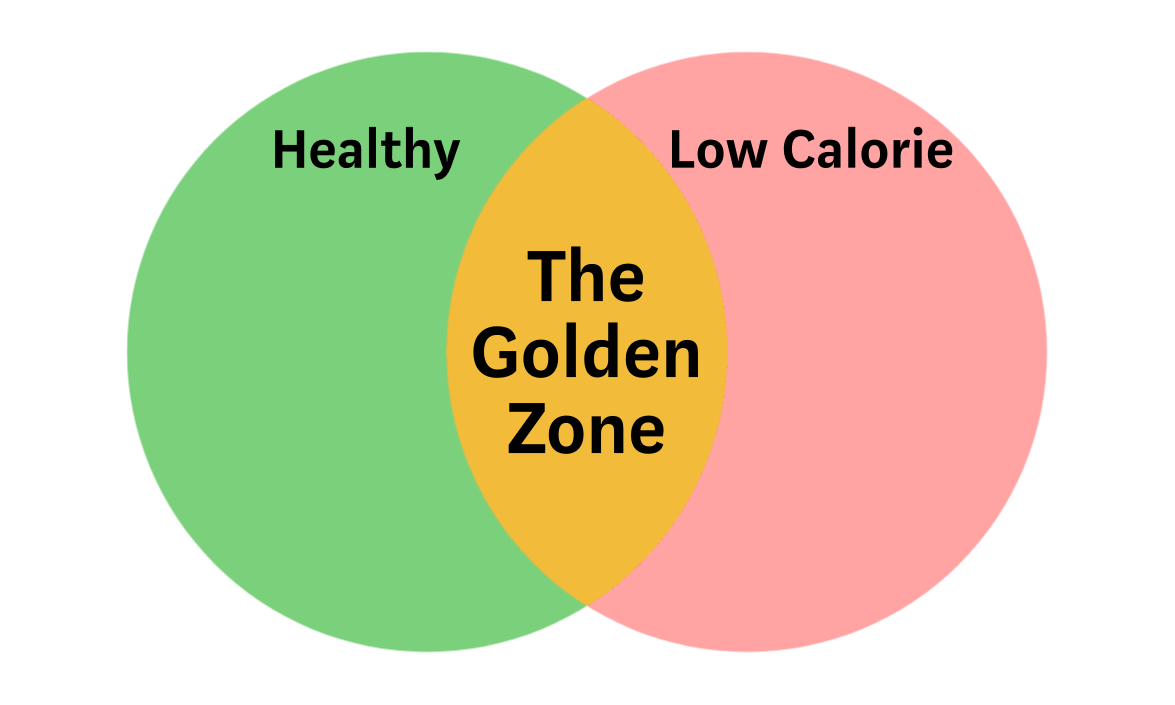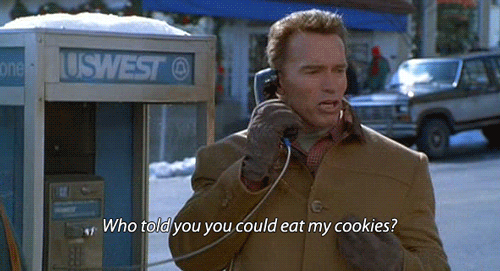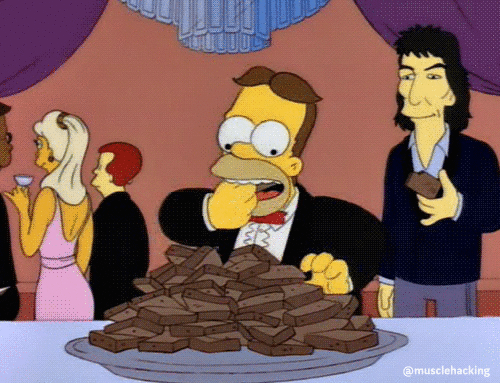There is a damaging and pervasive myth in the health and fitness industry.
Actually there’s a bunch of them, but this is a big one: the myth that eating healthy food will help you lose weight.
If you’ve ever been on a diet, you might have experienced being bombarded with people’s recommendations to eat a particular food because it is “healthy”.
It’s repeated by everyone from malicious marketers to well-meaning grandparents.
This recommendation contains the implicit assumption that healthy and low calorie are inseparable concepts.
The malicious marketer is delighted that you don’t understand the difference between healthy and low calorie. It allows them to label their product as one and know that you’ll assume the other.
Your well-meaning granny has no idea that there is a difference between healthy and low calorie. She just wants you to be happy.

“I baked you some healthy raisin cookies for your new diet!”
Although granny means well, there is a huge difference between calling a food healthy and calling it low calorie.
Healthy is used to describe foods that have a lot of micronutrients and/or other elements that improve your health in one way or another. Elements like antioxidants to help reduce free radicals (unstable molecules), anthocyanins for your brain, or fibre to help you poop.
Low calorie is used to describe foods that are low in calories (*whoa*). Calories are a measure of the energy inside your food.
When you consume more energy than you expend, the remaining energy is stored as fat (or muscle if you’re doing it right).
When you consume less energy than you expend, your body breaks down fat (or muscle) to make up the difference (you can use the leangains calculator to estimate your calories and macros). So eating low calorie food is a great way to lose weight.
Notice how the definition of healthy didn’t include any mention of weight loss? And the definition of low calorie didn’t include any mention of health? That’s because healthy ≠ low calorie.
Healthy food does not have to be low calorie, and low calorie food does not have to be healthy.
But that’s not to say it can’t be. When a food is both healthy and low calorie, that’s The Golden Zone.

Healthy + Low Calorie = The Golden Zone
The Golden Zone is the overlap between healthy and low calorie. These are the foods that tick all of your nutritional boxes.
Golden Zone foods are healthy. Depending on which food, this could mean protection against heart disease and cancer, reduced inflammation, improved memory, better insulin sensitivity, and many other characteristics that we associate with good health.
Golden Zone foods are low in calories. This makes them great for keeping you full, and helping you lose weight.
Examples of Golden Zone foods are: white fish, eggs, cottage cheese, and most vegetables (full table shown here). They are nutrient dense from both a calorie and volume perspective, which means they will help keep you full in the moment and healthy long term.
A diversified diet rich in Golden Zone foods is ideal for weight management and long term health. That translates to a better looking, more athletic, and disease-free you.
So this begs the question… how many eggs do you have to eat before your 6 pack shows up? Are you allowed to eat anything that’s not a Golden Zone food? And wasn’t eating an ‘apple a day’ already enough to avoid medical intervention entirely?
Well let’s back up a bit. First off, there are at least 2 good reasons to avoid eating Golden Zone foods.
Reason #1: You’re Bulking
Bulking is intentionally eating in a calorie surplus in an attempt to gain weight. We almost always want this weight in the form of muscle, not fat (with sumo wrestlers being the obvious exception).
Some people have difficulty eating enough food during a bulk to reach their calorie target. If you’re one of those people, then you have good reason to not eat Golden Zone foods.
Why? Well since Golden Zone foods are low calorie – and you’re struggling to get enough calories – you’re better off sticking to the pure healthy zone foods. This will allow you to more easily hit your calorie targets whilst still getting a large amount of nutrients.
To help hit your calorie targets, some common substitutions include:
- Replacing chicken breast with fattier cuts of beef.
- Replacing almonds with macadamias.
- Replacing spinach with sweet potatoes.
- Replacing toothpaste with peanut butter.
Etc. Now this obviously doesn’t make Golden Zone foods ‘bad for you’ in this situation. They’re just not the best choice, given your goals.
Reason #2: You’re Human
A bit tongue-in-cheek, but this will present itself in one way or another. If you’re in this for the long term, then you’re guaranteed to find yourself in many situations that make 100% clean eating near impossible.
Situations like:
- Having a big night out with the boys after getting a promotion
- Your boss offering you their home-baked cookies the morning of your performance review
- Dominoes cheaper Tuesdays
Etc. In all seriousness, there are practical reasons to not eat Golden Zone foods. Sometimes they won’t be available. Sometimes you’ll splurge during a special event.
Alternatively... you could intentionally include unhealthy food as a part of your diet.

But you didn’t hear it from me.
Eating the Cookie on Purpose
Let me start with a quote from nutrition researcher Alan Aragon from his book The Lean Muscle Diet:
“Dietary perfection is a myth. It doesn’t exist. There is no Unicorn Diet for humans. Ten percent of the diet coming from anything you want might sound rebellious until you switch things around and see that 90 percent of the diet is a diligent effort to cover all the bases…”
– Alan Aragon
Alan recommends taking a 90/10 approach to dieting:
- 90% from whole and minimally processed foods (with some exceptions, like whey protein)
- 10% from whatever you want (which Alan calls “pure junky goodness”)
Alan also shares a few anecdotes of people who have lived for a very long time while subsisting on common “junk” foods. Like the late George Johnson who lived to 112 years old eating ‘a diet largely of sausages and waffles’.
Quite a few of the longest-living humans also seem to have had a weak spot for chocolate.

“Did he just say chocolate is good for me?”
While I don’t find these anecdotes all that convincing on their own – they feel similar to the stories smokers tell you of their 99-year-old chain-smoking marathon-running grandpa – there is wisdom within Alan’s recommendation.
There are diminishing returns to the benefits of eating micronutrient-rich sources of food. Studies that show the largest benefits are almost always in the context of correcting a deficiency. This is fundamentally different to putting the finishing touches on an otherwise admirable diet.
If you are eating fish every day, then you won’t see much benefit taking fish oil. If you are in the sun for most of the day, then you won’t see much benefit taking vitamin D. And if you’re eating a lot of fruit, then you won’t see much benefit taking vitamin C.
Why? Because you don’t get bonus points for going over your micronutrient needs.
Now all this is based on the notion that you’re able to cover all your bases with only 90% of your diet. Which you most definitely can – if you’re eating whole and minimally processed foods. That translates to food in the healthy zone.
If you’re eating Golden Zone foods, you’ll be able to cover your bases with ~80% of your diet. Why? Well that’s 80% of your diet calorie-wise. So Golden Zone foods – which are by definition nutrient dense and low calorie – are a great way to get the nutrients you need without going over your calorie budget.
Vegetables get a special shout out here for being low calorie with a diverse assortment of vitamins and minerals – see broccoli and spinach for great examples.
Crunching the Numbers
Let’s say you calculate your calories to be 2000 calories per day. 10-20% of that gives you 200-400 calories/day of “pure junky goodness” to work with. We’ll take the average of 300 calories/day for the below examples.
You can consume these ~300 calories as a “daily treat”, or you can bank the calories and use several days’ worth in one sitting. Some ideas:
- 1 Original Glazed Krispy Kreme every day (~193 cal)
- 1 KitKat Chocolate bar every day (~209 cal; the full 4 fingers – not the recommended 2 finger “serving size”)
- 200g of Cookies & Cream Connoisseur Ice Cream every 2 days (~540 cal; I doubt anyone has ever followed the 64g “serving size”)
- 5 slices of Dominoes BBQ Meatloves pizza every 3 days (~810 cal)
- 1 large Big Mac Meal every 5 days (~1476 cal)
Knowing how many calories are in your favourite junk foods helps you make more satisfying meal choices.
For instance, the above dot points tell me that I should never go to McDonalds. Why? Because not only do I prefer the taste of pizza over a Big Mac, but it’s also a lot less calories for what I would consider a satiating meal. So going to Dominoes instead of McDonalds makes sense from a taste and calorie point of view.
Now if you love McDonalds and crave a Big Mac above all else, then that’s fine too. If you’re happy with the trade-off, then enjoy a guilt-free Big Mac.
As long as you stay within your calorie budget – spend your junk calories on whatever food your taste buds’ desire.
Wrapping it Up
You could be forgiven for forgetting this post was about eating healthy, low calorie foods – not optimising how much pizza you can cram into your diet.
Some take-away points:
- Healthy and low calorie mean very different things
- You can’t go wrong eating Golden Zone food – food that is both healthy and low calorie
- It’s okay to eat pure junky goodness sometimes – approximately 10-20% of your diet is fine
There is no one way to diet – just as there is no one way to parent a child or roast a turkey. But there are terrible ways to do all three.
So don’t get burned by another fad diet.
Think about the food in the Golden Zone that you enjoy the most. Basing your diet around this food is an effective and practical way to achieve lasting aesthetics and health.
And since we’re creating a diet that will last, we will include some room for indulgence.
Healthy, Low Calorie, or Golden Zone
The table below gives typical examples of Healthy, Low Calorie, and Golden Zone foods.
The table is not comprehensive – in part because there are too many foods in existence to classify. But it should be more than enough to get started.
There are always going to be edge cases and points of disagreement, and I’ve added a few footnotes to address some of these. You can email me if you would like to suggest a change.
| Healthy | Golden Zone | Low Calorie |
|---|---|---|
|
|
|
ˆ Potatoes, sweet potatoes, corn, and green peas are on the line between Healthy and Golden Zone.
♠ Figs and mangoes are on the line between Healthy and Golden Zone.
† These foods are on the line between Healthy and Golden Zone. The final decision as Healthy/Golden Zone was made by considering how filling a standard serving size is relative to comparable Healthy/Golden Zone foods. For example, comparing the calories and satiation for a serving of brown rice vs. a serving of oats.
Comment
Note that I am a participant in the Amazon Services LLC Associates Program, an affiliate
advertising
program designed to provide a means for me to earn fees by linking to Amazon.com and affiliated
sites.
Some of the links in this post are affiliate links, and if you click on them
and make
a
purchase, I will earn a small commission (at no extra cost to you).
I never let this
commission
cloud my judgement when recommending products.
I
recommend
what I think is the best, irrespective
of the $ involved.
